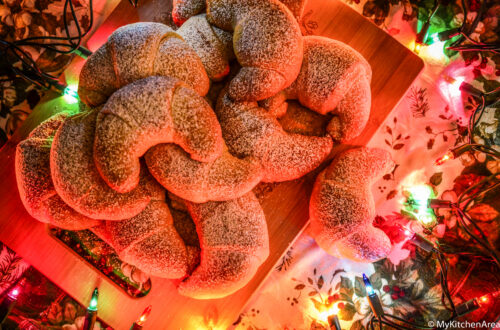
Pan de Muerto

Do you love the spooky season around the Halloween? I do! But there was no really pure Halloween spirit in Slovakia when I was a kid. During the Cold war and socialism era some of the old traditions had vanished. What was normal before WWI and WWII was considered as western traditions and some were deliberately forgotten. At least we always carved some pumpkins and light the candles on graveyards and cemeteries. Fortunately after the Velvet revolution some of the old traditions started returning slowly. One of the really old traditions is baking soul cakes – “dušičky” – small yeasted buns shaped like bones, or buns filled with poppy seeds or walnuts.
So every Halloween I love to bake something spooky: jack-o-lantern cookies, chocolate edible cockroach or cupcakes with gummy worms, among others. But I always adored the Mexican way of celebrating these Holidays. Sugar skulls – “calaveritas”, the Death Lady – “La Catrina” and beautiful soft brioche Bread of the Dead – “Pan de Muerto” on the ofrendas. A few years ago I decided that I should try to bake Bread of the Dead. I searched the internet and found that there are various types, sweet and savory, but the more traditional version is with the orange and aniseed. And because I love the sourdough too, here is my sourdough version of the Bread of the Dead.
Ingredients for the dough:
100g active wheat sourdough starter (100% hydration, bread/strong wheat flour)
500g all purpose flour
200g bread flour
140g sugar
180g egg (4 eggs size M)
200 ml milk
110g butter
10g salt
2 tbsp orange zest
2tsp anise extract
1tsp lemon extract
1 tsp vanilla extract
1 egg for the egg wash
Ingredients for the orange wash:
20ml rum
20 ml orange juice
2,5 tbsp of powdered sugar
Instructions:
Mix the starter, flours, eggs, milk, sugar, salt, zest and all the extracts. Knead until the dough is smooth and passes the window test. Then add the soft butter and knead until it is incorporated properly. At the end the dough should be soft and elastic. Cover the bowl with cloth or cling wrap. Leave it to rest, in this phase you can put it in the fridge or a cool place overnight. It has higher content of butter and it’s similar to a brioche. The cool slow fermentation helps to develop a beautiful taste and the butter will not sweat from the dough. But if you want, you can let it rest at RT, just be careful, the temperature shouldn’t be too high. Then leave it to rise until doubled.
In the morning take the dough from the fridge, if you chose the cool fermentation and leave it to rise at RT until doubled. After that punch it down and fold it into a round ball. Then, diverse the dough into 10 pieces (140 – 145g/piece).
For each pan you will need 100g for the body, 2x15g for the bone-shaped decorations and one small ball 12 – 15g for the symbol of the head. Round every 100 g piece and the small ball for the head. Roll every 15g piece into to a small 12cm (4,5 in) long log and shape it by rolling with fingers, soit’s thin in the middle and has two thinner parts between the middle and the edges – it resembles a bone (you should have 20 pieces of the bones, 2 per one Pan de Muerto). Put 2 “bones” crossing each other on the top of the big bun and on the top of the cross make a small dint in which you put the small ball – the “head”.
Let it rise again until it doubles. After the second rise, use the egg wash. Then bake in a preheated oven at 210°C (410°F) for 10 minutes and then lower the temperature and bake at 180°C (355°F). Bake until golden and the internal temperature reaches 89°C (192°F)(approx. 30 minutes). Prepare the orange wash by mixing all the ingredients and wash the breads with it while the are still hot. Then let them cool and enjoy.





One Comment
Ingrid
Thank you so much for sharing your recipes! It is very much appreciated.